2 Oct 2019
1 CommentCholera: Poverty, Urbanity, and Immigration
The threat cholera posed was not limited to the population’s health, but extended into political and social concerns of the era. When cholera arrived via Britain’s harbors and waterways in 1832, the disease swept across a nation agitated by political unrest and a deeply divided class system. The working population, disenfranchised and without democratic representation, were voicing their dissatisfaction with an incredibly unfair electoral system. The rich, land-owning gentry, who benefited from this unbalanced system, fought against reform efforts with a sense of great antipathy for the lower classes.
Cholera’s timely arrival commanded equal attention to the pushing matter of Reform and, being relevant to the issues at hand, was often highly politicized.
With the haunting figure of cholera looming ever closer to England, governmental officials knew the disease would hit its poorest citizens the hardest. Although operating under the erroneous theory of miasma, the correlation between disease and sanitation was recognized by the broader population. And nowhere was sanitation worse than in the poorest parts of English cities. English slums were overcrowded and densely packed, often several poor families would occupy one small room, with little to no ventilation. Cesspools were in close proximity to dwellings and only occasionally emptied; when they were emptied, the contents were dumped directly into the river, the neighborhoods source of drinking water. Sewers and drains often overflowed and large, stagnant pools of water often dotted the streets. Livestock were often kept in cellars or in enclosures connected to dwellings. Huge refuse piles out on the street were a common sight and were rarely collected for disposal. These conditions were believed to be the perfect breeding ground for miasmata, the noxious gas understood to cause disease.
Edwin Chadwick, a social reformer who had an incredible influence on sanitation, wrote in his Report on the Sanitary Condition of the Labouring Population of Great Britain:
the various forms of epidemic, endemic, and other disease caused, or aggravated, or propagated chiefly amongst the labouring classes by atmospheric impurities produced by decomposing animal and vegetable substances, by damp and filth, and close and overcrowded dwellings…
There was little sympathy to be had for England’s poorest citizens and the government wanted no part in assuming responsibility for the poor. But, in order to contain the epidemic, the government established local Boards of Health to spread information on preventative measures against cholera. From their inception, these boards were intended to be temporary organizations and were given no power to enact intervention beyond offering advice. Caught in the cycles of poverty and urbanization, these preventative measures and sanitary protocols were often beyond the reach of the poor to begin with.
While miasma was understood to emanate from urban environments, it was not confined to those spaces. Miasmata could spread through a location by the changing currents of air or, sometimes, even at will, making no one safe from the noxious vapor propagated by the poor.
Blame for cholera’s spread was placed squarely on the shoulders of Victorian society’s most vulnerable, the inhabitants of these urban environment: the laboring classes and immigrants.
A Court for King Cholera reproduces an impoverished urban landscape believed to be the breeding ground for disease. Unfortunately, while certain aspects of this print are exaggerated, the overall sanitary condition of this English slum was not far off from the real thing. In the lower left corner, we see a child head-first in a pile of rubbish while an old woman scavenges through it for useful refuse. Next to them, we see a group of unattended children all playing with a dead rat – a clear signifier of contagion and squalor. A woman in the lower right-hand corner surveys the scene while smoking a pipe, her infant lying neglected at her feet. The street is filled with a throng of people, many of them idle, illustrating the overcrowded and closely packed nature of these dwellings. Amongst the bustle of the people we see a figure carrying a coffin presumably carrying the newly dead. A common sight, it would seem, as the throng of people do not stop to bat an eye at the spectacle. One man sporting a top hat can be seen among the crowd, indicating him as a member of the middle to upper class, either partaking in slumming—a form of urban tourism for the well-to-do—or on a philanthropic mission.
This print was published in Punch Magazine, a periodical primarily directed at a middle-class audience. Readers of the time, well-versed in the visual signifiers of class and race within this print, would have well understood the moralizing tone of this comic. The print depicts not the victims of circumstance, but an idle and profligate population whose surroundings reflect their moral degradation.
In the same report mentioned earlier, Chadwick wrote:
That the younger population, bred up under noxious physical agencies, is inferior in physical organization and general health to a population preserved from the presence of such agencies… the population so exposed is less susceptible of moral influences, and the effects of education are more transient than with a healthy population… these adverse circumstances tend to produce an adult population short-lived, improvident, reckless, and intemperate, and with habitual avidity for sensual gratifications… these habits lead to the abandonment of all the conveniences and decencies of life, and especially leads to the overcrowding of their homes, which is destructive to the morality as well as the health of large classes of both sexes.
Notably, Chadwick’s quotation portrays the laboring population as subhuman. The urban environment breeds an adult population deficient in manners both moral, physical, and intellectual. These thoroughly degenerate adults then give themselves to sinful habits like drink, idle behavior, neglectful of the young they are meant to be raising. Their “inferiority” lead them to further propagate the unsanitary conditions that shaped them into immoral and subhuman adults. As a result, their habitat becomes both the cause of their corrupt state as well as the means to reproduce the environment that shaped them. To wit, the poor are a race apart; both the product and the source of their own poor health and degeneration.
In the foreground, we see the particularly prominent racialized figure of an Irish immigrant. The sign in the background, which reads ‘Logins for Thravelers’, not only carries with it the connotation that many immigrants frequent this urban landscape, but can be read as a phonetic spelling of the Irish brogue.
A significant portion of the poor population were Irish immigrants, who, like the laboring class as a whole, were blamed for the spread of cholera.
A letter published in the Manchester Guardian reported:
By means of Irish vagrants from Sunderland, the cholera has been twice brought amongst us. The first suspicious case occurred at a lodging-house in the Half Moon Bank. A man called Mallan, a rambling Irish cobbler, had attended his father at Sunderland, who died of cholera, had assisted in laying out the body; and attending to the last offices; concluding in the Irish fashion by a regular row, getting drunk, and lying a great part of the night in the street. This man, coming to Shields immediately afterwards, took ill, and in a short time fell a victim to his folly. Another Irish vagrant, who has a lodging at the head of Toll-street, went over to Sunderland to collect rags and beg. He returned home to his wife and four children drunk, and after abusing his wife shamefully, was taken ill of cholera.
The author’s abject blame falls upon the Irish Immigrants from Sunderland, where the first reports of cholera cases
originated, heralding the arrival of the epidemic in England. He draws a distinct connection between the ‘profligate’ nature of these Irishmen and the methods through which they contract the disease. Mallan falls ill after getting drunk and lying out in the street, and he succumbs not to the disease but “to his folly.” The second account outlines how the husband’s drunken abuse of his family preceded his falling ill, making his disease appear to be divine punishment for his immoral behavior, rather than actual bodily contagion.
The figure of the immigrant, like the poor population they belong to, were scapegoats for the origin and spread of cholera. This association between immigration and disease has long legs in the history of medicine and especially in that of cholera.
The correlation between cholera and the immigrant ‘other’ is one that continued to persist through the late 1800’s. Above we see John Tenniel’s “Back!” where the national personification of Britannia bars the gaunt, shrouded figure of Cholera from entering her country. Noticeably, the figure of the immigrant is no longer the Irishman of the 30’s, but the far more topical figure of the 1890’s—the Jew. The racialized figure of the Jew populates the boat Cholera has boarded to travel into England. Like the Irishman in A Court for King Cholera, the Jewish man directly behind Cholera bears exaggerated features by which we can identify him as other. His hooked nose, his long beard, and the fur hat he wears allow us to identify him as a caricature of the Russian Jews fleeing the pogroms of the 1880’s onward.
These two images show how the immigrant was often the scapegoat that bore the blame for cholera making its way to England. It’s a nebulous position that shifts accordingly with the times, but always presented as figure to loathe and fear.
Attitudes concerning reform were far from uniform therefore neither were the applications of cholera into political rhetoric. Officials blamed cholera for exciting political unrest in the people and inciting riots. To upper-class opponents, cholera was emblematic of the threat reform posed to the status quo. Enfranchisement, like cholera, could penetrate the divided class structure, negatively effect one’s living conditions, and generally spread chaos throughout a previously ordered system.
There was a rumor that gained traction among reform proponents, especially those of the working population, that false reports of cholera were being used to distract attention away from the Reform Bill. Or, similarly, that cholera was being deliberately spread throughout England to kill off the poor, causing the push for reform to die down while also generating profit for doctors and Board of Health officials.
Middle-class proponents and sanitation reformers viewed the arrival of cholera as a cause for reform, a timely example of how the state was failing it’s poorest citizens.
Regardless of opinion, it was clear that in the minds of English people, cholera was intimately tied to the political issues of the day. The London Medical Gazette noted on 18 June 1831:
[Cholera] divides attention with the reform bill. No medical man can enter a house without being questioned about it; and the papers, both at home and abroad, teem with the most alarming accounts. In short, there is complete panic.
The cartoon above, John Bull Catching the Cholera, instances one way cholera extended into the sphere of politics. John Bull, the national personification of England, seizes the throat of Cholera–shown here as a blue-skinned, Indian figure–while the Reform Bill lies at the man’s feet. While it’s political message is difficult to derive, the comic illustrates the uneasy, complex relationship cholera had with a rife political climate. Notably, how cholera and reform, as the biggest issues of the day, were conflated.
The following quotation from Cholera: A Biography by Christopher Hamlin nicely sums the threat cholera posed as a national issue.
Cholera’s greatest insult was to progress itself. Not as a disease that individuals died from but as an invader of continent, state, or town, cholera violated a sense of a European identity that was being applied to other places as they succumbed to civilization.
The process by which cholera struck felt like an invasion, and not just in the way that it spread. Cholera was an explicitly foreign disease to the English; one they first encountered in their militaristic occupation of India. So, to the English national conscience, cholera appeared as an invasive foreign figure, strikingly similar to the immigrants they feared and derided. It follows, then, that cholera was not confined to the medical field, but permeated into other parts of society as well. Cholera wasn’t just a disease but an unwelcome, alien figure in the English landscape, threatening all walks of life regardless of class or politics with its destructive thrall.
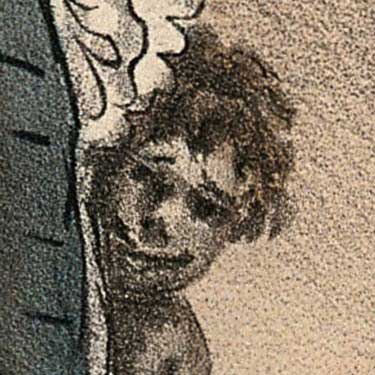
Emily Winter is an archivist of everything from the miasmatic to the purulent.

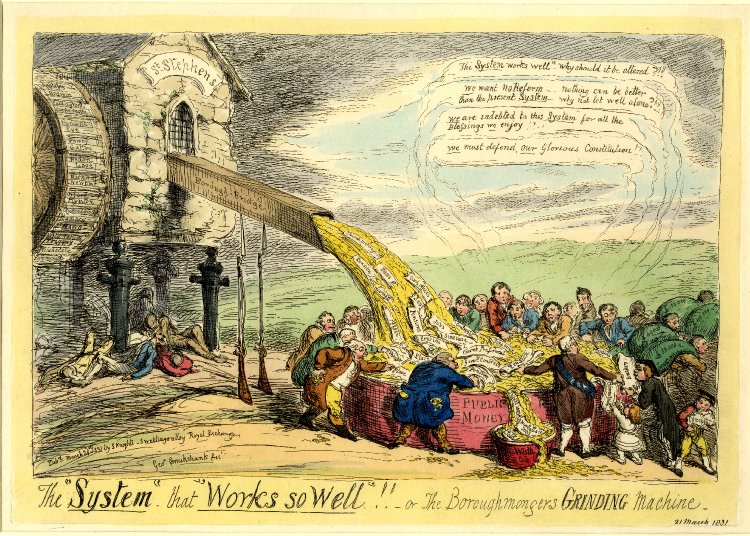
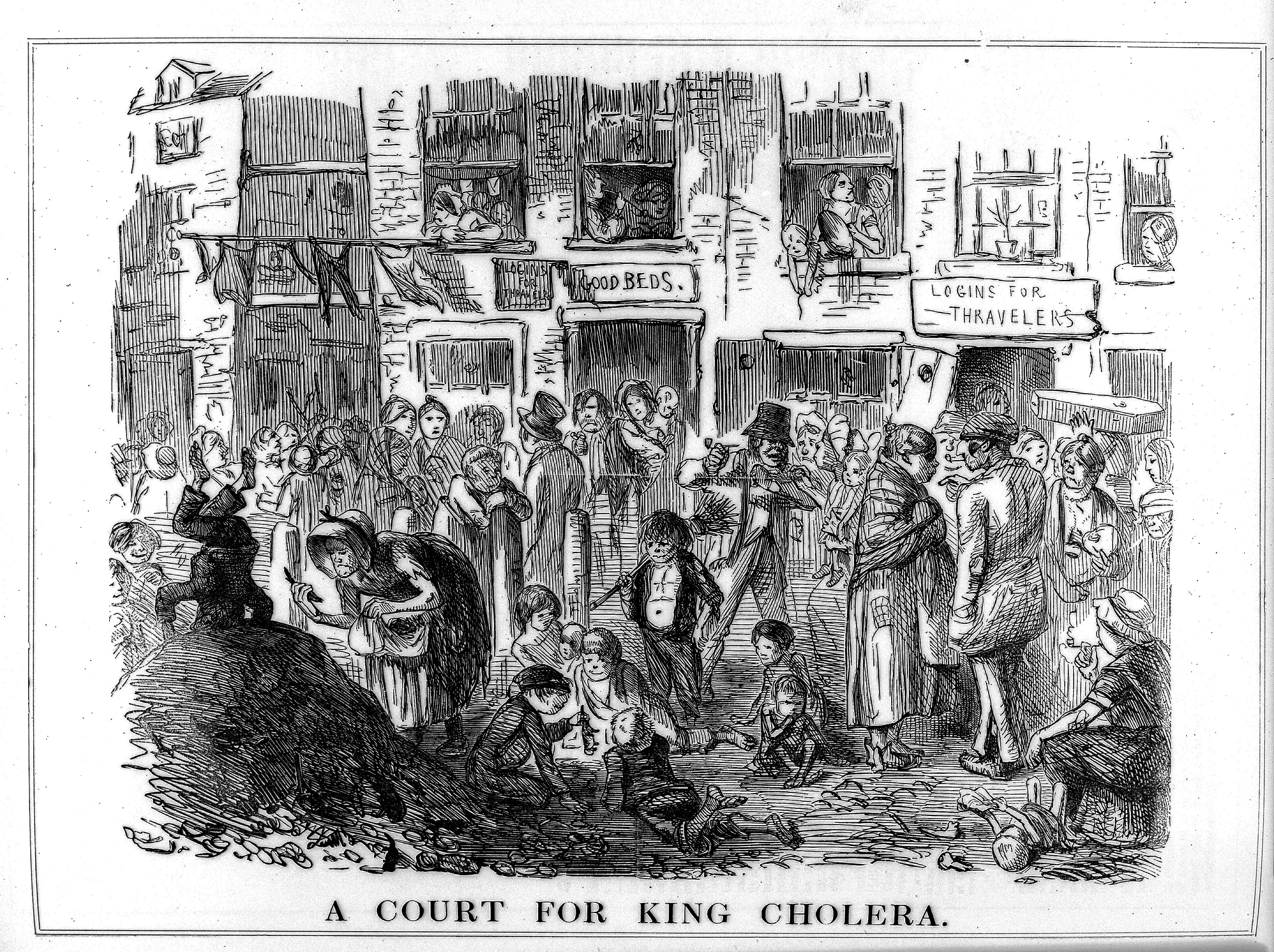
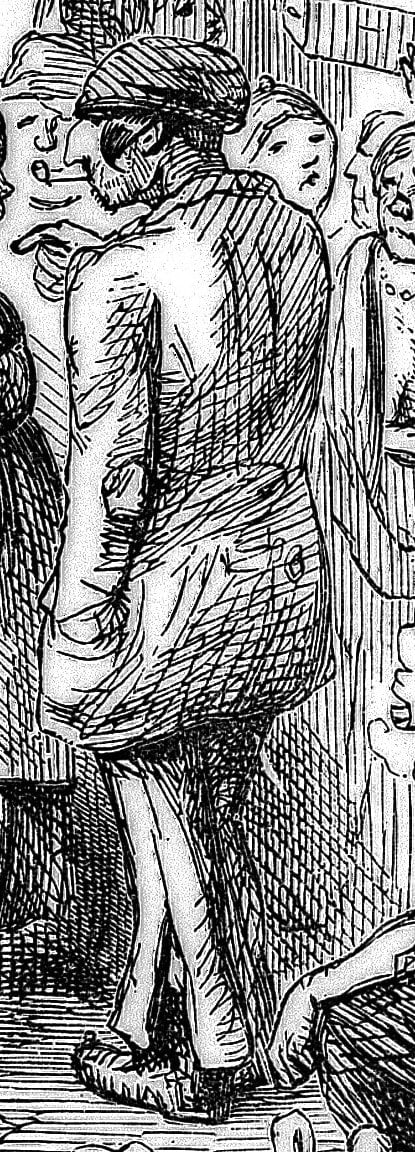

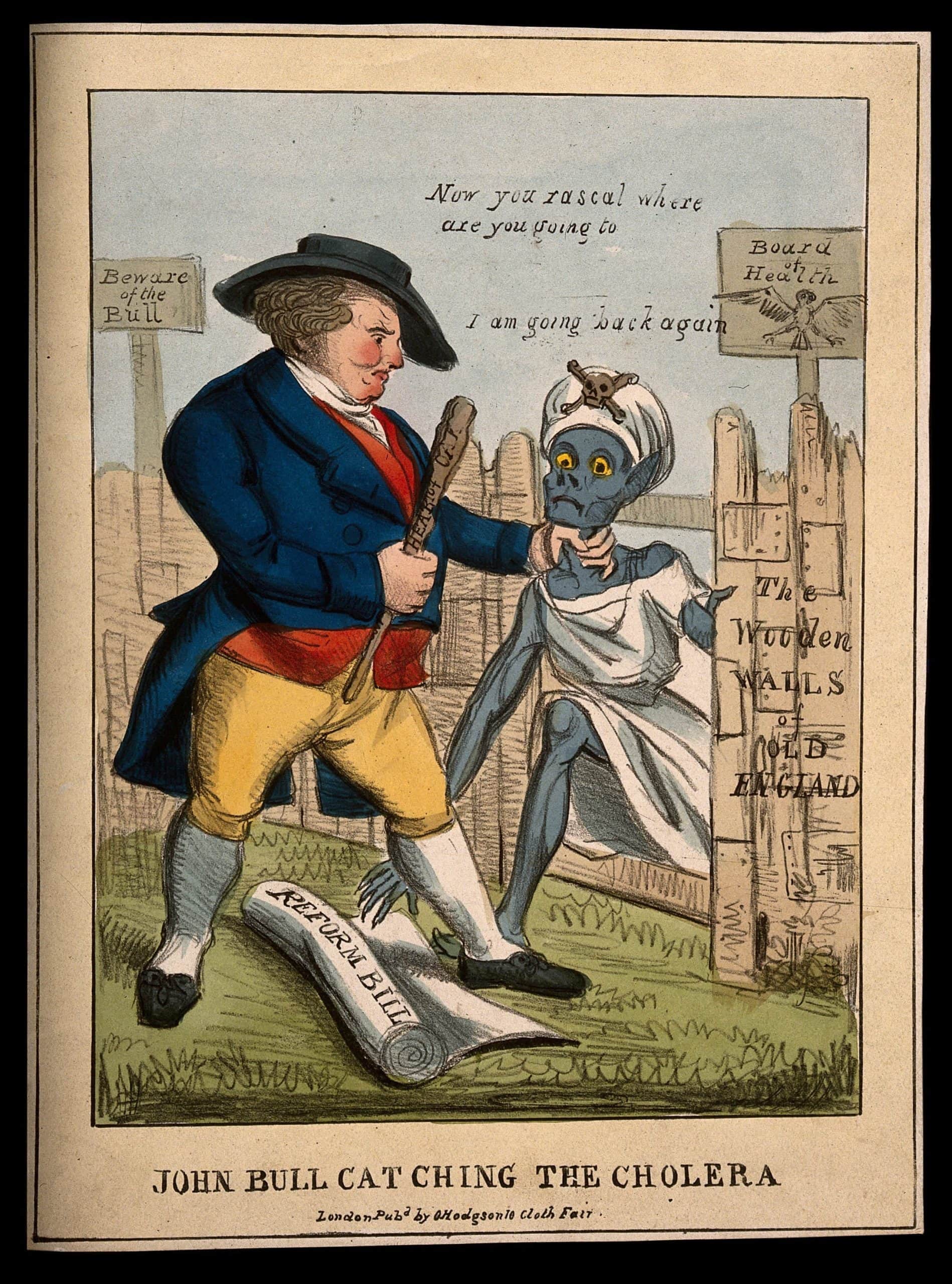
Coronavirus & Anti-Chinese Cartooning – Drawing Blood
February 1, 2020 @ 11:44 pm
[…] we have written about elsewhere at this site, the resurgence of xenophobic editorial cartoons in the wake of a new global disease […]